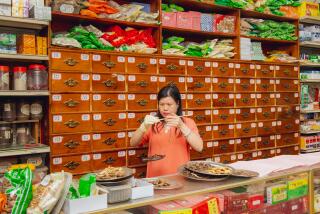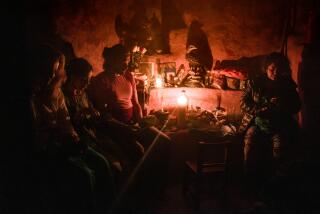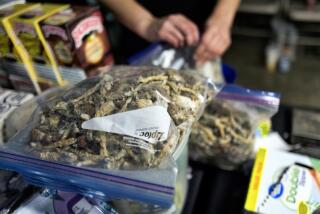Scalpel vs. herb in China
- Share via
Xikou, China — THE fur is flying, not to mention the acupuncture needles, the firewort and the $15,000-a-pound bull gallstones. China’s ancient healing arts, as integral to national identity as the Great Wall or steamed dumplings, have become embroiled in the country’s struggle to balance tradition and modernity.
A relatively obscure professor at a regional university kicked off the controversy in October with an online petition calling for traditional medicine to be stripped from the Chinese Constitution. It has a protected status here that, at least in theory, guarantees it equal footing with its Western counterpart.
Professor Zhang Gongyao and fellow critics have blasted Chinese medicine as an often ineffective, even dangerous derivative of witchcraft that relies on untested concoctions and obscure ingredients to trick patients, then employs a host of excuses if the treatment doesn’t work.
For adherents of the 3,000-year-old system, this borders on heresy. The Health Ministry labeled Zhang’s ideas “ignorant of history,” and traditionalists have called the skeptics traitors bent on “murdering” Chinese culture.
Ironically, the firestorm dovetails with a growing embrace of Chinese medicine abroad as an antidote to the perceived soulless, money-obsessed nature of Western healthcare.
On a trip to China in mid-December, U.S. Health and Human Services Secretary Mike Leavitt said the two countries planned to trade lessons on how to integrate Western and Chinese medicine.
“It’s an area of interest for China and the U.S.,” he said.
Many Australians, Europeans and Americans see the limitations of advanced science, said Rey Tiquia, an expert in Chinese traditional medicine based in Australia, even as more Chinese view their traditions as old-fashioned.
“For Chinese,” he said, “it’s still the lure of something new and shiny, like riding a car rather than a bicycle.”
Since 1949, the number of traditional doctors trained in China has fallen by nearly half to 270,000, while the number of Western-trained doctors has jumped twentyfold to more than 1.7 million.
Criticism that traditional medicine is not scientific dates back centuries. But Zhang’s prescriptive remedies -- including an end to national insurance coverage for traditional medicine, rigorous scientific standards and obligatory Western training for traditional doctors -- have hit a nerve at a time when traditional Chinese medicine is increasingly on the defensive.
At Beijing’s prestigious Xiehe Hospital, cardiology, gynecology, internal medicine and other Western specialties are housed in a new six-story building filled with shiny equipment, well-maintained halls and renovated toilets. The traditional medicine department is relegated to eight consulting rooms and a therapeutic facility in an outer building with peeling green paint, water-stained walls and a foul smell emanating from a dimly lighted toilet.
Some blame skewed financial incentives and a government that is forgetting its roots.
“The Health Ministry is actually the Ministry of Western Health,” said Lin Zhongpeng, a researcher with the Beijing Tianren Yiyi Traditional Medicine Institute. “It’s also shocking that doctors get 15% kickbacks selling Western drugs.”
TRADITIONAL remedies tend to be less expensive than Western ones. At the Tongrentang traditional pharmacy and clinic along Dashila alley in Beijing, a dozen people waited for football-sized bags of herbs for a few dollars each.
“Give me some deer sinew,” said one customer, asking for a traditional cure for arthritis. “Large or small?” a clerk in a white coat asked, grabbing several from a tray.
But there are some notable, more expensive exceptions. In glass cases, beneath an ad touting an herbal tonic for avian flu, shelves brimmed with dried snakes, sea horses, ground-up pearls and deer horn powder, used for ailments such as rheumatism, paralysis, asthma, epilepsy, gastritis and acute infantile convulsions.
Nearby sat an ornate green box lined with red satin holding a shriveled deer penis and testicles ensemble for $63 -- nature’s apparent answer to Viagra. “That’s to improve male function,” an employee explained helpfully.
Deer privates at nearly a month’s average wage hardly top the price list.
“The most expensive would be bull gallstones,” a clerk said, pointing at a yellowish shrink-wrapped object the size of a nickel, used for fevers and inflammation.
In an adjoining building, third-generation traditional doctor Guan Qingwei examined several patients, prescribing different herbal combinations for insomnia, high-blood pressure and rashes.
Unlike Western medicine, which focuses on the disease, traditional medicine takes a holistic approach, he said. Adherents of “ZangXiang,” one of the discipline’s fundamental tenets, believe the body gives external clues to the imbalance of internal organs, which can be rectified with herbs and acupuncture. This makes knowledge of anatomy unnecessary, he said.
Both systems have their strengths, Guan said, but judging traditional medicine according to Western scientific theory and using “double blind” tests on herbal remedies is inappropriate.
“Not only is it unfair, it’s laughable,” he said. “It’s like judging hamburgers based on the taste of dumplings.”
Although Chinese schools pump out thousands of traditional medicine graduates each year, nearly half never practice -- they chose the specialty because other departments were full.
This is in contrast with the United States, where most people who study medicine are mature, highly motivated students.
A Chinese government delegation on a recent visit to California said the U.S. could surpass China soon as the best place to learn traditional medicine, said Lixin Huang, president of the American College of Traditional Chinese Medicine in San Francisco, the nation’s oldest such graduate program.
Traditional medicine in China tends to be more popular in rural areas and among older people, in part because of its lower cost.
Each day here in the farm village of Xikou, traditional doctor Liu Huade, 92, sees as many as a dozen patients suffering from ailments such as kidney failure, “women’s problems” and liver tumors. Until a few years ago, he picked all of his own herbs in the nearby mountains.
Liu Qiuyao, 59, stopped by to have his pulse checked. Privacy was hardly a concern as a dog wandered in and out of the one-room consultation area accompanied by several villagers eager to chat or buy pills.
Two years ago, Liu, an impoverished farmer, spit up blood and was told to go to a Western medicine hospital, but he couldn’t afford it. So he came to the traditional doctor, who cured him with herbs.
“I’d rather come here,” he said, his right eye fused shut beneath a shock of unkempt hair. “When a prescription is too expensive, Dr. Liu tells me where to pick the herbs myself.”
A common criticism of Chinese medicine involves its often-unregulated ingredients.
“Many herbal medicines considered innocuous are actually very toxic,” said Fang Zhouzi, a biochemist, columnist and founder of a website that targets academic fraud. “But practitioners and proponents cover this up using various excuses.”
THE U.S. Food and Drug Administration banned products marketed as Chinese herbal medicine during the 1970s and ‘80s after they were implicated in several deaths. In 2004, the FDA issued a ban on the controversial herb ephedra after it was linked to heart attacks and strokes.
Chinese traditional experts blame misuse. They point to guan mu tong, which has been used for centuries to treat urinary tract infections. Problems surfaced only when Westerners used it incorrectly as part of a weight loss therapy, they say.
Nor are Western drugs free of powerful side effects, others counter.
“Why don’t people talk about Western medicines that cause problems?” said Zheng Jinsheng, a professor at the Academy of Chinese Medical Sciences in Beijing, who thinks both disciplines have their place. “Why is traditional medicine always blamed?”
Chinese medicine’s use of endangered animal and plant ingredients also has been cause for concern. Officially, China forbids trading in the items, but rising incomes and old habits threaten species worldwide.
Only about 30 Chinese tigers, hunted for their bones and other parts, remain in the wild, experts estimate, compared with tens of thousands a few decades ago. Tiger parts are used for rheumatism and to increase virility.
Substances such as bear gallbladder bile are legal, but the cruel conditions under which they are “farmed” have attracted worldwide criticism.
“People in China need to change their values,” said Mang Ping, associate professor at Beijing’s Central Institute of Socialism. “And most of the time there are replacements in traditional medicine.”
Dog bones, for example, are now recommended in lieu of tiger bones, buffalo horns for rhinoceros horns.
Western medicine was introduced to China by missionaries in the late 16th century, though it remained largely a curiosity for centuries. Starting in the early 19th century, missionary hospitals became more widespread as European nations elbowed for influence in a weakened China.
“There was a proverb that the door that couldn’t be opened with a gun could be opened with a single surgery knife,” said Zheng, the professor at the Academy of Chinese Medical Sciences.
In 1914 and again in 1929, pro-Western governments tried unsuccessfully to ban traditional medicine as backward and unsafe, spurred by the likes of intellectual Liang Qichao, who had his healthy right kidney accidentally removed by Western-trained doctors but still sung their praises.
Traditional doctors, threatened with the loss of their livelihoods, spread rumors that Western doctors removed Chinese organs and stored them in their churches, using children’s hearts in demon rituals.
“We must never forget our roots,” said Li Jian, 46, a business consultant, accompanying his father to a traditional doctor for a liver ailment. “Western medicine always tries to judge traditional medicine from its perspective. Maybe if China becomes very powerful one day, we’ll return the favor.”
*
Yin Lijin of The Times’ Beijing Bureau contributed to this report.
More to Read
Sign up for Essential California
The most important California stories and recommendations in your inbox every morning.
You may occasionally receive promotional content from the Los Angeles Times.










